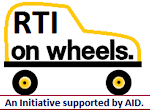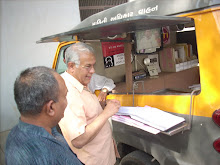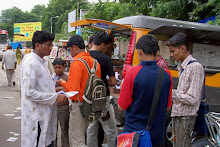Indian
Express: New Delhi: Sunday, 18 October 2015.
Shyamlal
Yadav: There is a perception that the government wants to weaken the RTI. What
is your experience of working with the previous government and this one?
No, there is
no change because the RTI Act, the system itself, is channelised and has been
given a certain direction. RTI is widely accepted as a lifeline. It is a
no-frills, cost-effective and efficient lifeline. The RTI Act itself is very
simply enacted and as it completes 10 years, it will bring out issues that are
of importance. The tenth year also gives us the opportunity to take stock of
our experience and set the stage for the future. There is scope for improving implementation
(of RTI) for which we have to build the infrastructure. We are following up
with the government to construct a building where every commissioner will be
able to sit, where there will be a library, an auditorium. That will help
strengthen our autonomy. Right now, we are divided into two campuses.
The other
important aspect is that we should have the wherewithal to provide immediate
relief to somebody if required. We are also trying to be able to build our own
institutional grid. On August 28, we invited all state information
commissioners for a meeting where we discussed whether implementation is in
step with the legislative intent, talked about identifying gaps in the RTI law,
apart from building of capacities, getting into the jurisprudence of a few
things, etc.
Shyamlal
Yadav: You say there has been no change in attitude of the government, but how
do you explain the delay of over nine months in your appointment as CIC which
has led to a pendency of some 12,500 cases /complaints before you?
Before I took
over, we were working as usual. When I took charge, I was anyway generally
chairing all the commission meetings. And you’ll see soon how well we have been
able to control the mounting pendency. The statistics will improve very soon.
Ritu Sarin:
We’ve heard this government is very wary of RTI disclosures, file notings and
leaks to the media. Are you noticing a trend where bureaucrats are writing less
and less detail in file notings and giving staccato instructions on file? Is
the fear of disclosure changing the art of writing?
No.
Exemptions from disclosure clauses are fairly clear. If there is a problem with
any disclosure, the information provider can resort to those exemptions. But
times have changed tremendously in the last 10 years. It was unthinkable for
annual confidential reports to be in the hands of the recipient. But now you
can get almost anything unless it is something very, very particular. And the
system has become quite institutionalised now. It is a multi-tiered system: the
top tier, which is a little closer to the systems we read about in the
newspapers, a mezzanine level that is the first appellate authority, and the
PIO who is working at the ground level and is close to the information seeker.
The information seeker and the information provider may be sitting in the same
office. When the Act came, in 2005, maybe there was hostility or hesitation.
When the employees themselves started using (the Act) for their personal and
establishment matters, it became more universal in usage. The question now is
not so much whether there is a hesitation, it is more whether the information
seeker is getting the relevant, usable information, and whether the information
is timely. And that is what we intend to discuss… also how to rationalise the
RTI Act further. So we are looking at the gaps.
P
Vaidyanathan Iyer: What are the gaps you hope to improve? In Maharashtra, for
example, we hear of RTI activists using the Act as a tool for extortion.
The canvas is
huge. I’ll touch on one aspect frivolous and vexatious applications. What is
vexatious to a certain respondent is not vexatious to another. So it is a
little difficult being clinical and pigeon-holing what is vexatious and what is
not. The second aspect is that there should be a legal filter. A legal filter
implies there is inherent objectivity. And why should we not filter out what
clearly (should be), and then you might say that in a certain department, this
would be okay, and in another this would not be the case. The three military wings
are within the RTI, so is the Ministry of Environment and Forests and so is
Panchayati Raj. These are very open ministries in any case. For instance, the
Rural Development Ministry has all those rural employment programmes. The third
would be how to deal with the boutique, fashionable variety (of cases) for
things that are not into citizen welfare. PhD research scholars send dozens of
applications to banks, asking all kinds of questions. Some banks give replies,
others say they can’t because they just don’t have the resources. And then the
appellant argues one bank has given him a reply, why can’t the other.
There are no
ready-made, clear solutions. What was being done almost entirely by the
government agencies is also being done by the private sector. Some want airline
passenger safety information, etc. These are not government agencies. Our law
and our system work on what has been enacted and how the state has been
defined.
Ritu
Sarin: What is the scope of RTI to include private bodies which have public
dealings?
It is clearly
defined that the RTI Act is about public authorities. These authorities perform
public functions, which are now (also) performed in the PPP mode, by the
private sector, even old-age homes, orphanages, etc. Many countries are clear
that RTI is a fundamental, human right. So the competent authority of that
country has the power to declare that a private entity carrying out public
functions be covered under the RTI if it is notified. But our system is
confined to public authorities, and the public authority is defined.
No one has
touched the RTI Act. There are windows for the dissemination of information, if
you look carefully. So the citizen can access information a regulatory
authority has about a private entity, if, under the law enforced, the
regulatory authority has that information. How strong are our administrative
agencies that regulate bodies which provide public services, be it buses,
airlines or hospital services? Surely there must be some way to get that
information. About the Bhopal incident, we read about it in the local papers.
Nobody thought whether it was a government entity or non-government entity. The
nineties was the golden age of PILs. Today, you have an Act. So these are some
of the questions we grapple with. These are all jurisprudential questions.
Unni Rajen
Shanker: The first reaction to an application is to use a technicality to
reject it, like, saying you are not a citizen but part of an institution.
Shyamlal
Yadav: One of the IITs wrote to me that since I am employed with The Indian
Express, I can’t be treated as a citizen of India.
We had a lot
of these technical things in the beginning. Now the stream of RTI applications
coming in is so huge that people do not want to study why they should not be
given the information. You provide the information. Don’t go into the
technicality too much, ask for citizenship. The idea is to give the
information. Not giving information on the basis of technicality is now a thing
of the past.
Shyamlal
Yadav: Who misuses RTI? You said a few researchers do it, some say lawyers and
people in the corporate sector misuse it. What is your experience?
There is a
trend of disgruntled employees filing applications driven by grudge or
vendetta. This is not what the RTI system was meant for. But the law doesn’t
disallow them from filing RTI applications. The basic idea was that those who
are in need of information should be able to access it. If it is also helping
in redressal of grievances, then it’s very good. But it was not meant really
speaking for addressing the problems which should have been resolved by
departments.
Shyamlal
Yadav: Of the 250-300 cases you dispose off in a month, how many are a misuse
of RTI?
I will
explain. There are three types… One, the employee who genuinely needs the
information, but the department is not giving it to him. He takes the route of
the RTI Act, and rightly so, and gets that information. The other ones are
very, very routine, like – how have you calculated the interest for my house
building advance? And they say, look, surely you must be having all the
accounts, why don’t you calculate it yourself? But he’s insistent and one fine
morning he gets that information also. If he has not got it and he comes to the
commission, we say bring the file and give him the calculation sheet. There are
some which you can describe as problem areas where an unknown employee who is a
habitual RTI applicant and may have filed applications in such large numbers
that it might astound you. It is unfair on the system and it is unfair on the
information provider, and that information has been given many times earlier.
Then there’s
another category which says I want this information because when I was working
in so and so capacity in 1982 or 1978… and I want the papers. Huge departments
like Railways didn’t have the system then of maintaining such records. It becomes
quite a burden. We want to make the RTI Act purposive and effective, for which
efficiency is required. You don’t want the information channels to be clogged
by frivolity or flippancy because the genuine information seeker should be able
to get that information.
Shalini
Nair: Why is the judiciary often allowed to get away by saying it doesn’t come
under the purview of the RTI Act?
All public
authorities come under the RTI Act. This is what the law says.
Shyamlal
Yadav: The Supreme Court is yet to accept that it is a public authority under
RTI Act. Cabinet notings, political parties all top offices are going against
RTI. In this situation, what do you think is the future of RTI?
All public
authorities, which include all government agencies, come under the RTI Act. But
the law also provides for exemption from disclosure clauses. If the information
provider makes a case that this information is coming under any of these
exemption from disclosure clauses, then they have a case. In that instance,
there would be the testing of the exemption from disclosure clauses vis-à-vis
the public interest; whether public interest should override, whether that
would be paramount over the exemption from disclosure clause.
Amitabh
Sinha: The commission had ordered that all the information that has already
been provided should be put out in the public domain on departmental websites
so that it drastically reduces the number of fresh applications coming in. What
happened to that order?
Compliance is
a big issue. Compliance, building capacities, low capacities are big issues…
You are talking about Section 4 of the Act. It is about suo motu, voluntary
disclosure, so that one does not not need to file an RTI application for
information which is already being supplied. But many said that such
information would not have the nature and scope which the RTI applicant wants.
Let me give you an example that should be there on the website. A huge number
of people ask about career prospects for an MSc in forensic medicine. A
university website should have this information. People ask what kind of loans
can I get under this scheme? What is the procedure of the passport? Who are the
beneficiaries of so and so subsidy? It is under the legislation of that
particular rural employment programme, it should be on the web. So Section 4 is
a very good idea. And I would say that it should not be confined to the 17
aspects mentioned under it. It should be far wider and not mechanical. It
should not be a normal auditor kind of thing or a tick box approach. It has to
be done with a lot more care and feeling that, yes, the entire information that
public wanted is there. That is part of the evolution of RTI.
Appu
Esthose Suresh: Now that it’s 10 years since the RTI was enacted, do you think
it’s time for a study to decide what are the go-areas and no-go areas and how
we can reform the Act? Do you also think there is a need for starting a
service, like you you have Indian Information Service? It’s evolving as a very
specialised institution so do you feel the need to build a body?
Before this
Act, there were these ideas that build a body and have a cadre system. That did
not find favour for many reasons, one of them being you don’t need another
bureaucracy. When I was involved with the National Green Tribunal Act, the
original idea was that it would be the national environment tribunal. Then
gradually it was decided to bring in forests and wildlife. But you can’t bring
in everything; you can’t make it so huge. Many of the experts on whom we place
our reliance about the environment, for example, came from the non-government
sector. They had clear views like should we have CNG or should we have low
sulphur diesel? The RTI does not have such dialectic because everybody is for
RTI and it does not have those kind of technicalities. It is run by the
citizens on the basis of their disaggregated demand. They run that kind of a
formation from a huge number of departments.
Another
important thing is that the RTI Act while it has given you a channel and it
has given you an instrument you can’t use it to light up every corner. It’s a
huge world in which we’re living. We just discussed that these are public
authorities and these are government agencies but what about those who are a
little bit of public but not fully? Let me give you an example. There was this
appellant who said that she was working in Delhi and went to Mumbai for some
work. When that appellant was going over a bridge, there was a collision and
something that shouldn’t have happened, happened. The railways there rushed her to a private
hospital and that private hospital put an implant and now she wants the
details.
The private
hospital has their own point of view because they say this was one of their
projects which have a little bit of an IPR (Intellectual Property Rights). But
she says she needs them for these reasons and these reasons are very good. So
you have to take calls and these are all very individual, human calls.
That’s what
the RTI is about and whether you have a cadre or you don’t have a cadre, when
the rubber meets the road, you take a call. You don’t have to necessarily read
every provision; the general idea is to do the right thing. So we don’t have to
deal with that cadre.
Shyamlal
Yadav: Which departments are most resistant to RTI?
This has to
essentially function like a tribunal it should be simple. The main distinction
between a tribunal and the court system is that the tribunal should have
everything very simple the logic should be explained simply. For everything,
you don’t want to take the support of the precedent. Also you can’t be very
technical that so and so has not asked the question in the RTI application.
Maybe as a supplementary he wants to know; maybe the person who drafted the RTI
application was not a very good draftsman. So the system has to run with the
element of the homespun it has to be comfortable and functioning, it cannot be
very heavy set. So sometimes when departments become a little too technical, we
have a problem.
(Transcribed
by Dipankar Ghose, Mahender Singh Manral and Aranya Shankar)














































































